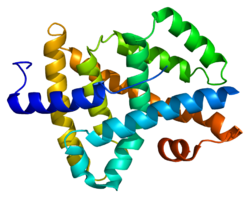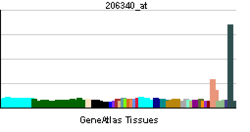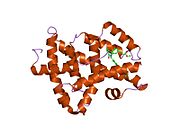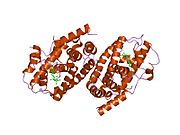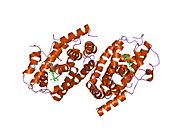- Farnesoid X receptor
-
The bile acid receptor (BAR), also known as farnesoid X receptor (FXR) or NR1H4 (nuclear receptor subfamily 1, group H, member 4) is a nuclear receptor that is encoded by the NR1H4 gene in humans.[1][2]
Contents
Function
FXR is expressed at high levels in the liver and intestine. Chenodeoxycholic acid and other bile acids are natural ligands for FXR. Similar to other nuclear receptors, when activated, FXR translocates to the cell nucleus, forms a dimer (in this case a heterodimer with RXR) and binds to hormone response elements on DNA, which up- or down-regulates the expression of certain genes.[2]
One of the primary functions of FXR activation is the suppression of cholesterol 7 alpha-hydroxylase (CYP7A1), the rate-limiting enzyme in bile acid synthesis from cholesterol. FXR does not directly bind to the CYP7A1 promoter. Rather, FXR induces expression of small heterodimer partner (SHP), which then functions to inhibit transcription of the CYP7A1 gene. In this way a negative feedback pathway is established in which synthesis of bile acids is inhibited when cellular levels are already high.
Interactions
Farnesoid X receptor has been shown to interact with Peroxisome proliferator-activated receptor gamma coactivator 1-alpha[3] and Retinoid X receptor alpha.[4]
References
- ^ "Entrez Gene: NR1H4 nuclear receptor subfamily 1, group H, member 4". http://www.ncbi.nlm.nih.gov/sites/entrez?Db=gene&Cmd=ShowDetailView&TermToSearch=9971.
- ^ a b Forman BM, Goode E, Chen J, Oro AE, Bradley DJ, Perlmann T, Noonan DJ, Burka LT, McMorris T, Lamph WW, Evans RM, Weinberger C (June 1995). "Identification of a nuclear receptor that is activated by farnesol metabolites". Cell 81 (5): 687–93. doi:10.1016/0092-8674(95)90530-8. PMID 7774010.
- ^ Zhang, Yanqiao; Castellani Lawrence W, Sinal Christopher J, Gonzalez Frank J, Edwards Peter A (Jan. 2004). "Peroxisome proliferator-activated receptor-gamma coactivator 1alpha (PGC-1alpha) regulates triglyceride metabolism by activation of the nuclear receptor FXR". Genes Dev. (United States) 18 (2): 157–69. doi:10.1101/gad.1138104. ISSN 0890-9369. PMC 324422. PMID 14729567. http://www.pubmedcentral.nih.gov/articlerender.fcgi?tool=pmcentrez&artid=324422.
- ^ Seol, W; Choi H S, Moore D D (Jan. 1995). "Isolation of proteins that interact specifically with the retinoid X receptor: two novel orphan receptors". Mol. Endocrinol. (UNITED STATES) 9 (1): 72–85. doi:10.1210/me.9.1.72. ISSN 0888-8809. PMID 7760852.
Further reading
- Kalaany NY, Mangelsdorf DJ (2006). "LXRS and FXR: the yin and yang of cholesterol and fat metabolism.". Annu. Rev. Physiol. 68: 159–91. doi:10.1146/annurev.physiol.68.033104.152158. PMID 16460270.
- Kuipers F, Stroeve JH, Caron S, Staels B (2007). "Bile acids, farnesoid X receptor, atherosclerosis and metabolic control.". Curr. Opin. Lipidol. 18 (3): 289–97. doi:10.1097/MOL.0b013e3281338d08. PMID 17495603.
- Seol W, Choi HS, Moore DD (1995). "Isolation of proteins that interact specifically with the retinoid X receptor: two novel orphan receptors.". Mol. Endocrinol. 9 (1): 72–85. doi:10.1210/me.9.1.72. PMID 7760852.
- Zavacki AM, Lehmann JM, Seol W, et al. (1997). "Activation of the orphan receptor RIP14 by retinoids.". Proc. Natl. Acad. Sci. U.S.A. 94 (15): 7909–14. doi:10.1073/pnas.94.15.7909. PMC 21528. PMID 9223286. http://www.pubmedcentral.nih.gov/articlerender.fcgi?tool=pmcentrez&artid=21528.
- Makishima M, Okamoto AY, Repa JJ, et al. (1999). "Identification of a nuclear receptor for bile acids.". Science 284 (5418): 1362–5. doi:10.1126/science.284.5418.1362. PMID 10334992.
- Parks DJ, Blanchard SG, Bledsoe RK, et al. (1999). "Bile acids: natural ligands for an orphan nuclear receptor.". Science 284 (5418): 1365–8. doi:10.1126/science.284.5418.1365. PMID 10334993.
- Bramlett KS, Yao S, Burris TP (2001). "Correlation of farnesoid X receptor coactivator recruitment and cholesterol 7alpha-hydroxylase gene repression by bile acids.". Mol. Genet. Metab. 71 (4): 609–15. doi:10.1006/mgme.2000.3106. PMID 11136553.
- Stegh AH, Barnhart BC, Volkland J, et al. (2002). "Inactivation of caspase-8 on mitochondria of Bcl-xL-expressing MCF7-Fas cells: role for the bifunctional apoptosis regulator protein.". J. Biol. Chem. 277 (6): 4351–60. doi:10.1074/jbc.M108947200. PMID 11733517.
- Cui J, Heard TS, Yu J, et al. (2002). "The amino acid residues asparagine 354 and isoleucine 372 of human farnesoid X receptor confer the receptor with high sensitivity to chenodeoxycholate.". J. Biol. Chem. 277 (29): 25963–9. doi:10.1074/jbc.M200824200. PMID 12004058.
- Huber RM, Murphy K, Miao B, et al. (2002). "Generation of multiple farnesoid-X-receptor isoforms through the use of alternative promoters.". Gene 290 (1–2): 35–43. doi:10.1016/S0378-1119(02)00557-7. PMID 12062799.
- Strausberg RL, Feingold EA, Grouse LH, et al. (2003). "Generation and initial analysis of more than 15,000 full-length human and mouse cDNA sequences". Proc. Natl. Acad. Sci. U.S.A. 99 (26): 16899–903. doi:10.1073/pnas.242603899. PMC 139241. PMID 12477932. http://www.pubmedcentral.nih.gov/articlerender.fcgi?tool=pmcentrez&artid=139241.
- Pineda Torra I, Claudel T, Duval C, et al. (2003). "Bile acids induce the expression of the human peroxisome proliferator-activated receptor alpha gene via activation of the farnesoid X receptor". Mol. Endocrinol. 17 (2): 259–72. doi:10.1210/me.2002-0120. PMID 12554753.
- Anisfeld AM, Kast-Woelbern HR, Meyer ME, et al. (2003). "Syndecan-1 expression is regulated in an isoform-specific manner by the farnesoid-X receptor". J. Biol. Chem. 278 (22): 20420–8. doi:10.1074/jbc.M302505200. PMID 12660231.
- Pircher PC, Kitto JL, Petrowski ML, et al. (2003). "Farnesoid X receptor regulates bile acid-amino acid conjugation". J. Biol. Chem. 278 (30): 27703–11. doi:10.1074/jbc.M302128200. PMID 12754200.
- Zhao A, Lew JL, Huang L, et al. (2003). "Human kininogen gene is transactivated by the farnesoid X receptor". J. Biol. Chem. 278 (31): 28765–70. doi:10.1074/jbc.M304568200. PMID 12761213.
- Barbier O, Torra IP, Sirvent A, et al. (2003). "FXR induces the UGT2B4 enzyme in hepatocytes: a potential mechanism of negative feedback control of FXR activity". Gastroenterology 124 (7): 1926–40. doi:10.1016/S0016-5085(03)00388-3. PMID 12806625.
- Holt JA, Luo G, Billin AN, et al. (2003). "Definition of a novel growth factor-dependent signal cascade for the suppression of bile acid biosynthesis". Genes Dev. 17 (13): 1581–91. doi:10.1101/gad.1083503. PMC 196131. PMID 12815072. http://www.pubmedcentral.nih.gov/articlerender.fcgi?tool=pmcentrez&artid=196131.
- Claudel T, Inoue Y, Barbier O, et al. (2003). "Farnesoid X receptor agonists suppress hepatic apolipoprotein CIII expression". Gastroenterology 125 (2): 544–55. doi:10.1016/S0016-5085(03)00896-5. PMID 12891557.
- Hsiao PW, Fryer CJ, Trotter KW, et al. (2003). "BAF60a mediates critical interactions between nuclear receptors and the BRG1 chromatin-remodeling complex for transactivation". Mol. Cell. Biol. 23 (17): 6210–20. doi:10.1128/MCB.23.17.6210-6220.2003. PMC 180928. PMID 12917342. http://www.pubmedcentral.nih.gov/articlerender.fcgi?tool=pmcentrez&artid=180928.
External links
- [3] (Nuclear Receptor Resource).
- MeSH farnesoid+X-activated+receptor
PDB gallery Transcription factors and intracellular receptors (1) Basic domains (1.1) Basic leucine zipper (bZIP)Activating transcription factor (AATF, 1, 2, 3, 4, 5, 6, 7) · AP-1 (c-Fos, FOSB, FOSL1, FOSL2, JDP2, c-Jun, JUNB, JUND) · BACH (1, 2) · BATF · BLZF1 · C/EBP (α, β, γ, δ, ε, ζ) · CREB (1, 3, L1) · CREM · DBP · DDIT3 · GABPA · HLF · MAF (B, F, G, K) · NFE (2, L1, L2, L3) · NFIL3 · NRL · NRF (1, 2, 3) · XBP1(1.2) Basic helix-loop-helix (bHLH)ATOH1 · AhR · AHRR · ARNT · ASCL1 · BHLHB2 · BMAL (ARNTL, ARNTL2) · CLOCK · EPAS1 · FIGLA · HAND (1, 2) · HES (5, 6) · HEY (1, 2, L) · HES1 · HIF (1A, 3A) · ID (1, 2, 3, 4) · LYL1 · MESP2 · MXD4 · MYCL1 · MYCN · Myogenic regulatory factors (MyoD, Myogenin, MYF5, MYF6) · Neurogenins (1, 2, 3) · NeuroD (1, 2) · NPAS (1, 2, 3) · OLIG (1, 2) · Pho4 · Scleraxis · SIM (1, 2) · TAL (1, 2) · Twist · USF1(1.3) bHLH-ZIP(1.4) NF-1(1.5) RF-X(1.6) Basic helix-span-helix (bHSH)(2) Zinc finger DNA-binding domains (2.1) Nuclear receptor (Cys4)subfamily 1 (Thyroid hormone (α, β), CAR, FXR, LXR (α, β), PPAR (α, β/δ, γ), PXR, RAR (α, β, γ), ROR (α, β, γ), Rev-ErbA (α, β), VDR)
subfamily 2 (COUP-TF (I, II), Ear-2, HNF4 (α, γ), PNR, RXR (α, β, γ), Testicular receptor (2, 4), TLX)
subfamily 3 (Steroid hormone (Androgen, Estrogen (α, β), Glucocorticoid, Mineralocorticoid, Progesterone), Estrogen related (α, β, γ))
subfamily 4 NUR (NGFIB, NOR1, NURR1) · subfamily 5 (LRH-1, SF1) · subfamily 6 (GCNF) · subfamily 0 (DAX1, SHP)(2.2) Other Cys4(2.3) Cys2His2General transcription factors (TFIIA, TFIIB, TFIID, TFIIE (1, 2), TFIIF (1, 2), TFIIH (1, 2, 4, 2I, 3A, 3C1, 3C2))
ATBF1 · BCL (6, 11A, 11B) · CTCF · E4F1 · EGR (1, 2, 3, 4) · ERV3 · GFI1 · GLI-Krüppel family (1, 2, 3, REST, S2, YY1) · HIC (1, 2) · HIVEP (1, 2, 3) · IKZF (1, 2, 3) · ILF (2, 3) · KLF (2, 3, 4, 5, 6, 7, 8, 9, 10, 11, 12, 13, 14, 15, 17) · MTF1 · MYT1 · OSR1 · PRDM9 · SALL (1, 2, 3, 4) · SP (1, 2, 4, 7, 8) · TSHZ3 · WT1 · Zbtb7 (7A, 7B) · ZBTB (16, 17, 20, 32, 33, 40) · zinc finger (3, 7, 9, 10, 19, 22, 24, 33B, 34, 35, 41, 43, 44, 51, 74, 143, 146, 148, 165, 202, 217, 219, 238, 239, 259, 267, 268, 281, 295, 300, 318, 330, 346, 350, 365, 366, 384, 423, 451, 452, 471, 593, 638, 644, 649, 655)(2.4) Cys6(2.5) Alternating composition(3) Helix-turn-helix domains (3.1) HomeodomainARX · CDX (1, 2) · CRX · CUTL1 · DBX (1, 2) · DLX (3, 4, 5) · EMX2 · EN (1, 2) · FHL (1, 2, 3) · HESX1 · HHEX · HLX · Homeobox (A1, A2, A3, A4, A5, A7, A9, A10, A11, A13, B1, B2, B3, B4, B5, B6, B7, B8, B9, B13, C4, C5, C6, C8, C9, C10, C11, C12, C13, D1, D3, D4, D8, D9, D10, D11, D12, D13) · HOPX · IRX (1, 2, 3, 4, 5, 6, MKX) · LMX (1A, 1B) · MEIS (1, 2) · MEOX2 · MNX1 · MSX (1, 2) · NANOG · NKX (2-1, 2-2, 2-3, 2-5, 3-1, 3-2, 6-1, 6-2) · NOBOX · PBX (1, 2, 3) · PHF (1, 3, 6, 8, 10, 16, 17, 20, 21A) · PHOX (2A, 2B) · PITX (1, 2, 3) · POU domain (PIT-1, BRN-3: A, B, C, Octamer transcription factor: 1, 2, 3/4, 6, 7, 11) · OTX (1, 2) · PDX1 · SATB2 · SHOX2 · VAX1 · ZEB (1, 2)(3.2) Paired box(3.3) Fork head / winged helix(3.4) Heat Shock Factors(3.5) Tryptophan clusters(3.6) TEA domain(4) β-Scaffold factors with minor groove contacts (4.1) Rel homology region(4.2) STAT(4.3) p53(4.4) MADS box(4.6) TATA binding proteins(4.7) High-mobility group(4.10) Cold-shock domainCSDA, YBX1(4.11) Runt(0) Other transcription factors (0.2) HMGI(Y)(0.3) Pocket domain(0.6) MiscellaneousCategories:- Human proteins
- Biochemistry stubs
- Intracellular receptors
- Transcription factors
Wikimedia Foundation. 2010.

